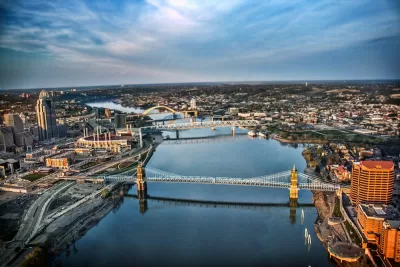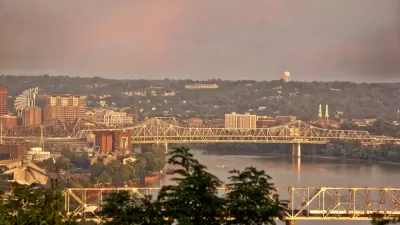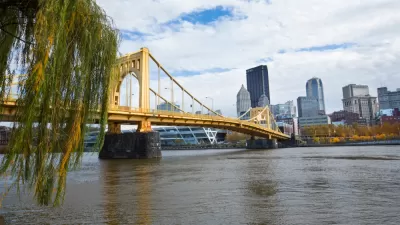Two of the transportation connections between Ohio and Kentucky in the Cincinnati metropolitan area were closed on the same day, leaving one side of the Ohio River cut off from the other.

The Brent Spence Bridge, an important artery for car and truck traffic between Ohio and Kentucky, closed on Wednesday after an overnight truck fire, according to Jake Ryle.
The Brent Spence Bridge is indicative of the massive challenges facing the nation's infrastructure. According to Ryle, "the bridge now carries more vehicles than it was originally designed to carry." Moreover, "the Brent Spence has been listed as 'functionally obsolete' on the federal bridge registry since the 1990s."
The failure of the bridge has Kentucky lawmakers scrambling to make the case for more transportation funding, including a potential bump in the gas tax.
Articles by David Winter and Sam Rosenstiel detail the frustrations the closure will cause commuters in the area.
On the same day as the Brent Spence closure, the John A. Roebling Suspension Bridge was also closed indefinitely "due to numerous and continued violations of the bridge’s weight limits," according to a statement from the Covington Police included in an article by Quinlan Bentley and Madeline Mitchell.
According to that article, "the Roebling, a historic bridge opened in 1867, has an 11-ton weight limit that was put in place after a 2007 inspection." All indications are that one bridge closure led to the other.
"The Cincinnati Police Department issued a warning Wednesday about the risks involved in driving a heavy vehicle -- such as a large delivery truck or semitrailer -- across the historic John A. Roebling Suspension Bridge while the Brent Spence Bridge is closed for an unknown amount of time," according to another article by Pat LeFluer.
FULL STORY: ‘Something has to get done': Community leaders push for solution after Brent Spence Bridge closure

Trump Administration Could Effectively End Housing Voucher Program
Federal officials are eyeing major cuts to the Section 8 program that helps millions of low-income households pay rent.

Planetizen Federal Action Tracker
A weekly monitor of how Trump’s orders and actions are impacting planners and planning in America.

Ken Jennings Launches Transit Web Series
The Jeopardy champ wants you to ride public transit.

Rebuilding Smarter: How LA County Is Guiding Fire-Ravaged Communities Toward Resilience
Los Angeles County is leading a coordinated effort to help fire-impacted communities rebuild with resilience by providing recovery resources, promoting fire-wise design, and aligning reconstruction with broader sustainability and climate goals.

When Borders Blur: Regional Collaboration in Action
As regional challenges outgrow city boundaries, “When Borders Blur” explores how cross-jurisdictional collaboration can drive smarter, more resilient urban planning, sharing real-world lessons from thriving partnerships across North America.

Philadelphia Is Expanding its Network of Roundabouts
Roundabouts are widely shown to decrease traffic speed, reduce congestion, and improve efficiency.
Urban Design for Planners 1: Software Tools
This six-course series explores essential urban design concepts using open source software and equips planners with the tools they need to participate fully in the urban design process.
Planning for Universal Design
Learn the tools for implementing Universal Design in planning regulations.
Ada County Highway District
Clanton & Associates, Inc.
Jessamine County Fiscal Court
Institute for Housing and Urban Development Studies (IHS)
City of Grandview
Harvard GSD Executive Education
Toledo-Lucas County Plan Commissions
Salt Lake City
NYU Wagner Graduate School of Public Service





























